What is the elevator screen in basketball
The elevator screen in basketball consists of offensive action that occurs when one particular player being guarded by a defender cuts through a small gap between two additional parallel players who then execute the elevator screen by immediately closing the gap before the defender has the opportunity to cut through it themselves.
From that point, the cutting offensive player could then receive the ball and possibly score, usually by way of an open jump shot from three-point range.
Why is the elevator screen potentially effective
The elevator screen is potentially effective because it is generally difficult for a defender being targeted by the screen to fight through it or evade it altogether.
In other words, a defender probably has at least a moderate chance to fight through or evade other types of basketball screens that are set by one offensive player.
The elevator screen, however, features two adjacent, parallel players working together to impede the defender’s movement and as a result of that, it could be a challenge for the defender to fight through or avoid both of those players.
What could cause the elevator screen to become ineffective
The offensive team and more specifically, the players involved in the elevator screening action, could potentially cause it to become ineffective if the timing is incorrect.
For example, let’s say that the player using the screen cuts too fast through the gap before the two parallel players are able to fully set and close it.
When that occurs, then the defender who is chasing behind that same player would most likely be able to cut through the gap as well, which basically defeats the purpose of the elevator screen.
As another example, let’s say that the two parallel players position themselves too early, essentially before the cutting player is in motion, ready to use the screen. In other words, the parallel players telegraph the screen.
When that happens, the defender guarding the cutting player might be able to read the screening action in advance and go around it, even if that route is a longer distance to that same cutting player.
Furthermore, if one of the parallel players attempts to close the gap while the defender is already cutting through that same gap, then this could possibly result in an illegal screen, also known as a moving screen violation.
Put another way, if a parallel player tries to close the gap but as that occurs, a defender is attempting to cut through that gap, then that same parallel player is essentially too late with their timing.
Therefore, if that parallel player makes contact with the defender, then it could be signaled as illegal because the parallel player, (i.e. the screener) does not give the defender the opportunity to avoid the contact, in that particular instance.
What could the defense do to limit the usefulness of the elevator screen
The defense could limit the usefulness of the elevator screen by implementing the defensive switching tactic.
Essentially, the screener’s defender could leave their original assignment to switch to the offensive player cutting through the elevator screen.
As that occurs, the defender that was the initial target of the screen could switch to guard the screener’s defender original assignment.
It should be noted though, that this particular switching action could possibly lead to defensive mismatches, especially for the player being targeted by the screen, who is usually a perimeter player such as a point guard or shooting guard.
Moreover, it should also be stated that the screener’s defender that would typically execute the switching action is the one that would be on the same side as the offensive player in possession of the ball.
So, if the offensive player in possession of the ball is near the right side wing and the elevator screen occurs near the high post elbows, then the screener’s defender that should generally switch would be the one that is near the right side elbow area.
Affiliate Disclosure: I may earn a commission on qualifying purchases made through the links below.
What are examples of simple basketball plays that use the elevator screen
Example 1
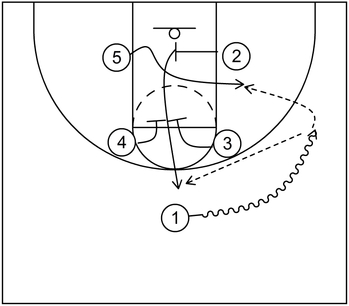
This is an example of a basketball play that uses the elevator screen from a box alignment alongside screen the screener action as well.
To start, 1 executes a dribble entry towards the right side wing and following that, 5 cuts to the right side wing via the cross screen set by 2.
Afterwards, 5 could possibly receive the ball from 1 and score near the basket with a low post move.
At the same time, 2 could cut towards the top via the elevator screen set by 4 and 5. Next, 2 could receive the ball from 1 and take the three-point jump shot if open.
Example 2
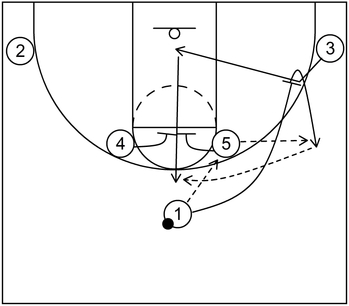
This is an example of a basketball play that uses the elevator screen within the Horns offense. Also, this simple play could be beneficial in a special situation such as when the team needs a three-pointer at the end of a quarter.
It is derived from Man-to-Man Side Ball Screen Offense with Quick Hitting Plays by Billy Donovan.
To begin, 5 receives the ball from 1 near the right side high post elbow. Afterwards, 1 cuts toward the right side corner to initially set a type of down screen, known as the wide pin down screen.
However, 3 rejects that screen to execute a backdoor cut towards the basket. From that point, 3 would generally receive the ball from 5 and score near the basket with a layup or dunk.
Nevertheless, for this case, 1 pops back towards the right side wing to receive the ball from 5. As that occurs, 3 cuts to the top via the elevator screen set by 4 and 5. Next, 3 receives the ball from 1 and takes the open three-point jump shot.
Example 3 – Part 1
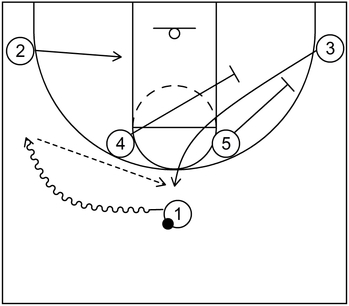
This is an example of a basketball play that demonstrates two sets of elevator screens from the Horns offense.
Additionally, this type of play could be favorable when the team desires to create a scoring opportunity for the best shooters, particularly near the perimeter areas of the court.
To start, 1 executes a dribble entry towards the left side wing and as that occurs, 3 cuts to the top via the elevator screen set by 4 and 5.
Furthermore, as that happens, 2 cuts from the left side corner to the left side low post block. Next, 3 receives the ball from 1 and takes the three-point jump shot if open.
Example 3 – Part 2
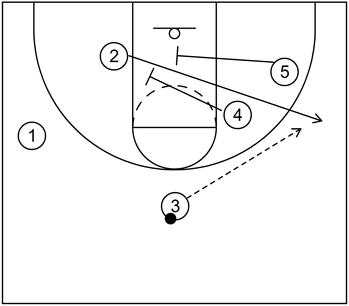
Continuing the action, if 3 receives the ball but is not open for the jump shot, then 2 cuts to the right side wing via another elevator screen set by 4 and 5. After that, 2 could receive the ball from 3 and take the open three-point jump shot.
Example 4 – Part 1
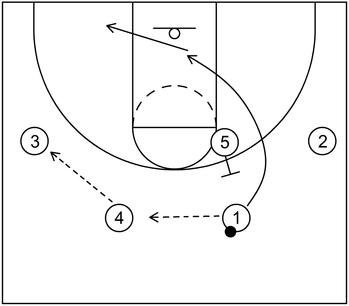
This is an example of a basketball play that utilizes action from the Chin series of the Princeton offense to create a scoring opportunity near the perimeter.
To start, 4 receives the ball from 1 and then 3 receives it from 4, which is also ball reversal.
Following that, 1 cuts to the basket via the back screen set by 5 near the right side high post elbow.
From there, let’s assume that 1 is not open to receive the ball from 3. Therefore, 1 cuts through to the left side short corner.
Example 4 – Part 2
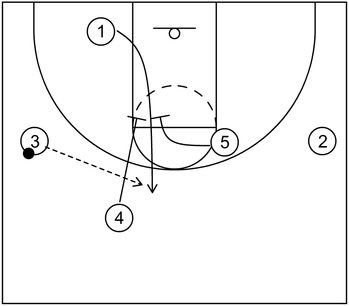
Next, 1 cuts to the top near the left slot via the elevator screen set by 4 and 5. Afterwards, 1 could receive the ball from 3 and take the open three-point jump shot.